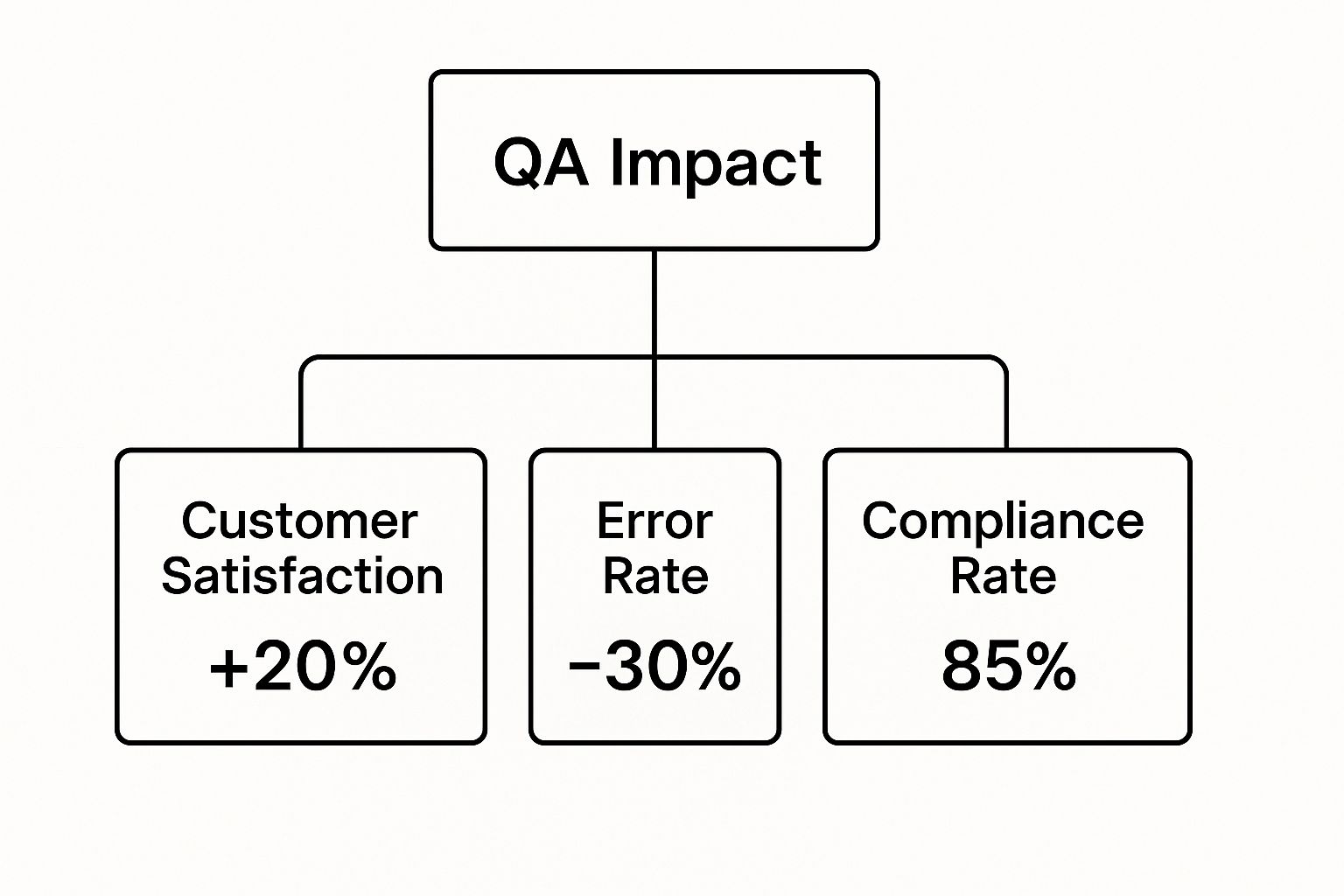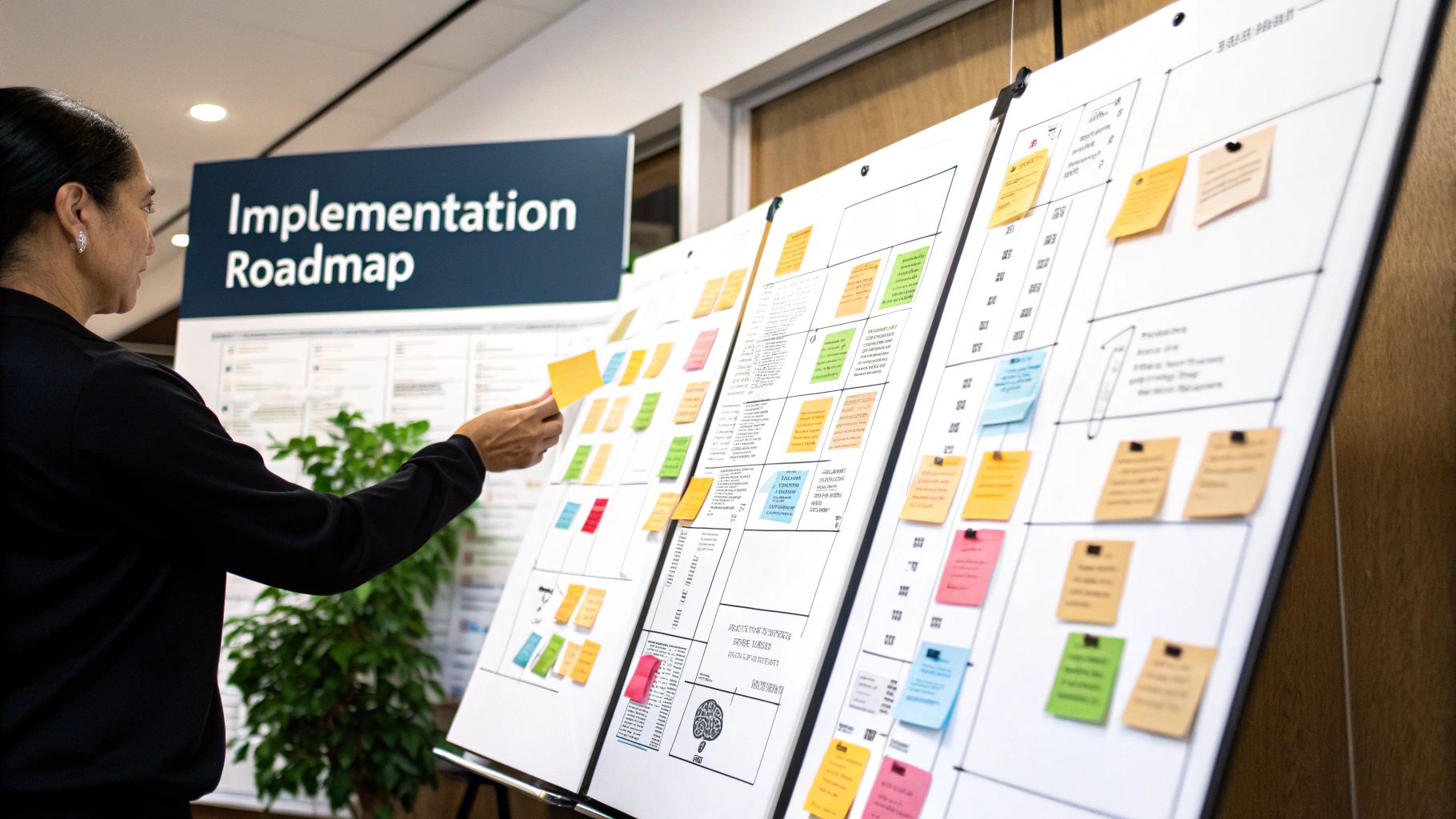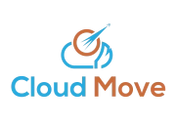Making Sense of Contact Center Quality Assurance

This screenshot showcases Zendesk's Talk platform. Notice how clean and user-friendly the interface is for managing customer interactions. The intuitive layout suggests it's easy for agents to navigate, leading to smoother customer experiences. Effective contact center quality assurance makes sure agents are using tools like this to their full potential, directly impacting customer satisfaction.
Think of it like a well-oiled machine: every piece, from agent training to the platform they use, contributes to the overall smooth operation and delivery of excellent customer service. This increased focus on customer service solutions is mirrored in market projections. The Middle East and Africa call center market is expected to hit USD 6309.68 million in 2024, growing at a CAGR of 12.2% through 2033. Discover more insights This growth really emphasizes the growing importance of contact centers in the region.
However, many misunderstand what contact center quality assurance actually is. It's often seen simply as a way to catch agents making mistakes. This viewpoint is not only wrong but also harmful. Instead of promoting a culture of improvement, it creates an atmosphere of fear and defensiveness. Effective QA should be a strategic growth driver, much like a coach helps athletes improve their performance.
Moving Beyond the "Gotcha" Mentality
Imagine a restaurant where servers are constantly criticized for minor slip-ups but never given credit for outstanding service. This environment likely leads to unhappy staff and a tense dining experience. Similarly, contact centers that only focus on identifying agent errors miss the chance to build a culture of continuous improvement.
This requires a shift in focus, from finding flaws to recognizing opportunities for growth. Instead of dwelling on what went wrong, effective contact center quality assurance programs highlight what agents did well and provide ways for them to build upon those strengths.
This encourages agents to see QA as a supportive resource, not a punishment. It's about empowerment, not reprimand. This change in perspective is essential for building a contact center where quality naturally flourishes.
Building a Culture of Quality
For example, consider an agent who efficiently resolves customer issues but struggles to express empathy. A traditional QA program might only concentrate on the lack of empathy, potentially discouraging the agent. A more constructive approach acknowledges the agent's efficiency while offering specific coaching to develop their empathetic communication.
This method builds on existing strengths and nurtures ongoing improvement. It lays the groundwork for exploring how to structure QA programs for maximum effect, moving beyond simple monitoring to become powerful tools for growth and customer loyalty.
Building QA Programs That Actually Work
Think of your contact center quality assurance (QA) program like a GPS for your agents. A good GPS doesn't just tell you when you've made a wrong turn; it shows you where you are, where you need to go, and how to get there. Similarly, effective QA provides agents with clear performance goals, identifies areas for improvement, and offers a roadmap for development. Too many programs focus only on the mistakes, leaving agents lost and frustrated.

The image above shows the potential impact of a well-designed QA program. We’re talking about a 20% increase in customer satisfaction, a 30% reduction in agent errors, and an 85% compliance rate. These aren't just arbitrary numbers; they represent the tangible results of focusing on the right aspects of QA.
Designing Effective Evaluation Criteria
Instead of rigidly enforcing rules and scripts, your QA program should prioritize customer outcomes. Imagine an agent who strays slightly from the script but ultimately solves the customer’s issue with empathy and efficiency. In a traditional, rules-based system, they might be penalized. A modern, customer-centric approach would recognize the positive interaction and the successful resolution.
This shift requires evaluation forms that provide actionable insights. Instead of vague feedback like "improve communication," offer specific examples. For example: "While you efficiently collected the customer’s information, offering reassurance about the resolution timeline would further enhance their experience." This kind of targeted feedback is much more helpful for agent development. And when considering overall quality assurance, it's beneficial to explore different facets, such as Content Quality Assurance which looks at the quality of written materials.
Implementing Constructive Review Processes
Think of reviews as coaching sessions, not disciplinary hearings. The goal is to build agents up, not break them down. Regular one-on-one meetings, where agents can discuss their performance and receive personalized guidance, are much more effective than infrequent, formal reviews. These regular check-ins foster trust and open communication, essential ingredients for a positive and productive work environment. For a deeper dive into monitoring performance, check out our guide on call center quality monitoring.
Developing Coaching Strategies That Stick
Effective coaching goes beyond identifying weaknesses. It equips agents with the tools and resources they need to grow. This could involve role-playing difficult scenarios, attending targeted training, or accessing a knowledge base of best practices.
Just as important as addressing areas for improvement is celebrating successes. Recognizing and rewarding agents who deliver exceptional customer service reinforces positive behaviors and motivates the entire team. This creates a culture where quality isn’t just an expectation, it’s a value.
To understand how traditional QA programs differ from modern approaches, take a look at the table below:
Essential QA Program Components Comparison
| Component | Traditional Approach | Modern Approach | Impact on Performance |
|---|---|---|---|
| Evaluation Criteria | Rule-based; script adherence | Customer-centric; focused on outcomes | Improved customer satisfaction; agent morale |
| Review Process | Infrequent; formal; often critical | Regular; informal; coaching-oriented | Increased agent engagement; trust building |
| Coaching Strategies | Focused on correcting mistakes | Development-oriented; provides tools and resources | Skill enhancement; performance improvement |
| Feedback Delivery | Generic; vague | Specific; actionable | Clearer direction for agents |
| Performance Measurement | Primarily quantitative (e.g., call times, error rates) | Qualitative and quantitative; considers customer feedback and agent growth | More holistic view of performance |
This table highlights the key differences between the old way of doing QA and a more modern, effective approach. By focusing on growth and development, rather than punishment and rigid adherence to rules, modern QA transforms from a source of stress into a valuable asset for both agents and the business.
Tracking Metrics That Drive Real Improvement

Let's be honest: many contact centers get bogged down in the wrong numbers. They obsess over easily tracked metrics like average call handle time (AHT) and sticking to the script, often losing sight of what truly makes customers happy and drives business success. It's like judging a restaurant solely on how quickly they clear tables, completely ignoring the food and the overall dining experience.
Imagine a contact center celebrating a super-low AHT. Sounds great, right? But what if agents are rushing through calls, leaving customers feeling unheard and frustrated? This can actually backfire, leading to more calls about unresolved issues and wiping out any efficiency gains from the lower AHT. That's why contact center quality assurance needs to go deeper than surface-level metrics. You might find this helpful: our guide on contact center KPIs.
Beyond Traditional Measurements
So, what should we be measuring? While AHT and script adherence have their place, the real focus should be on indicators that reflect genuine customer experience and agent effectiveness. Think First Call Resolution (FCR), which measures how often an issue is resolved on the first interaction. A high FCR means happier customers and lower costs by reducing the need for repeat calls.
Another important metric is Customer Effort Score (CES). This gauges how easy it is for customers to interact with your contact center. A low CES suggests a smooth, effortless experience, making it more likely customers will return and recommend you to others. These metrics provide a much more complete picture of your contact center's health than traditional measurements alone. On that note, the quality management software sector in MEA generated USD 412.8 million in 2024, and it's projected to grow at a CAGR of 7.6% from 2025 to 2030. Discover more market insights.
Building Trust Through Metrics
Effective contact center quality assurance also means using metrics to coach and develop agents, not to punish them. Think of a sports coach using performance data to help athletes improve their game, not just to point out their weaknesses.
When agents understand that metrics are tools for growth, they’re more likely to embrace feedback and strive for excellence. This creates a positive cycle, boosting both individual and team performance. It also fosters trust between agents and supervisors, building a culture of continuous improvement. By shifting the focus from penalties to development, contact centers can unlock the true potential of their teams.
To further illustrate the connection between QA metrics and business outcomes, let's take a look at the following table:
QA Metrics Performance Impact Analysis
| Metric Category | Customer Impact Score | Agent Development Value | Business ROI |
|---|---|---|---|
| First Call Resolution (FCR) | High (Directly impacts customer satisfaction) | Medium (Helps identify knowledge gaps and training needs) | High (Reduces repeat calls and operational costs) |
| Customer Effort Score (CES) | High (Reflects ease of interaction and overall experience) | High (Provides insights into areas for process improvement) | High (Improves customer retention and loyalty) |
| Average Handle Time (AHT) | Medium (Can be positive or negative depending on context) | Medium (Can highlight efficiency opportunities but shouldn't be the sole focus) | Medium (Potential for cost savings but must be balanced with customer satisfaction) |
| Adherence to Scripts | Low (Indirect impact on customer experience) | Medium (Useful for ensuring consistent messaging but can limit agent flexibility) | Low (Minimal direct impact on business outcomes) |
This table highlights how metrics like FCR and CES have a significant impact on both customer satisfaction and business ROI. While metrics like AHT and script adherence offer some value, their impact is less pronounced. The key takeaway here is to prioritize metrics that directly reflect customer experience and agent development.
Choosing Technology That Enhances Rather Than Complicates
The promise of technology in contact center quality assurance is alluring. Automated monitoring, AI-driven insights, and slick workflows all sound fantastic on paper. But the reality can sometimes fall short. Expensive platforms can end up creating more work, burying teams under clunky interfaces and overwhelming data. How do you see past the marketing gloss and pick technology that truly elevates your QA program?
Identifying Your Core Needs
Before you get lost in demos and feature lists, pause and define your core challenges. What are your biggest headaches? Are you drowning in manual monitoring processes? Is agent feedback all over the map? Do you lack a clear view of your key performance indicators? Truly understanding your needs will help you evaluate which tools actually solve your problems, not just offer bells and whistles you’ll never use.
Take a look at this dashboard from the Genesys platform:
The Genesys platform illustrates the importance of a clear, centralized dashboard. See how it brings together key information? Supervisors can potentially monitor agent performance and pinpoint areas for improvement quickly. This kind of real-time visibility can dramatically improve contact center QA.
Integrating, Not Disrupting
The best technology fits in with your existing systems – it doesn’t demand a complete rebuild. Look for platforms with open APIs and adaptable integration options. This way, you can connect it with your CRM, telephony system, and other essential tools. This minimizes disruption and makes the most of your current technology investments. This saves time, simplifies things, and creates a single, unified view of your contact center operations.
Think about the future, too. The contact center as a service (CCaaS) market in the Middle East is expected to hit USD 1,122.9 million by 2032, with a 12.9% CAGR. Learn more about CCaaS market growth. Choosing a flexible platform today will make it easier to adapt as the industry changes.
Focusing on Actionable Insights
A ton of data is useless if it doesn’t tell you anything useful. Choose platforms with strong reporting and analytics that present information clearly. Features like automated reporting, customizable dashboards, and AI-powered insights can reveal trends and patterns. This allows you to go beyond simply collecting data and actually use it to improve agent performance and customer experience. Tracking the right metrics is essential for meaningful improvement in your contact center QA. Want more on this topic? Check out this helpful article on customer success metrics.
Empowering Agents Through Technology
Technology should help agents, not hinder them. Look for platforms with features like integrated coaching tools, knowledge bases, and performance dashboards that agents can access directly. This gives them the resources they need to improve, building a culture of ownership and continuous growth. You might also find this interesting: our article about omnichannel contact centers.
By keeping these key considerations in mind, you can select technology that truly enhances your contact center quality assurance program. You can shift from manual, time-consuming processes to an automated, efficient system. This approach streamlines operations, empowers your agents, and ultimately leads to a better customer experience.
Implementing QA Programs That Stick
Let's talk about contact center quality assurance (QA) programs. Some thrive, some wither—and the difference often comes down to how you set them up. Think of it like planting a garden. Good seeds (your QA program) and fertile soil (your contact center) aren't enough. You need the right care to make it flourish. Even a well-designed QA program can flop without a smart rollout.
Securing Buy-In: From Top to Bottom
Imagine a restaurant kitchen trying a new recipe without the chef's okay. Disaster. Similarly, a contact center quality assurance program needs buy-in from everyone, from management to agents. This isn't about forcing compliance; it's about building understanding and shared responsibility.
Explain the "why." Show how the QA program benefits everyone. For management, highlight the potential return on investment – better customer retention, greater efficiency. Tools like call management software can amplify these benefits. For agents, emphasize professional development and how the program empowers them to give outstanding service.
Communication is Key: Transparency and Clarity
A good GPS gives clear directions, not just "wrong turn" alerts. Your QA program communication should be equally transparent and informative. Clearly explain the program’s goals, how performance is measured, and how feedback works. Address agent concerns openly and create ways for them to ask questions and share their thoughts. Transparency builds trust and reduces pushback.
Consider workshops or town halls to explain the program and address any worries. Offer hands-on training with the QA tools and provide continuous support. This proactive approach builds a collaborative environment where agents feel valued and involved.
Creating Sustainable Processes: Build for the Long Haul
A gardener has to water and weed consistently. Maintaining a contact center quality assurance program also needs ongoing effort. Set up a clear process for monitoring performance, giving feedback, and adjusting the program based on data and what you hear from your team.
Build a system that’s easy to manage and can grow with your needs. Don’t try to do everything at once. Start with a few key elements, get them working well, and then gradually add more. This phased approach lets you refine processes, collect feedback, and ensure the program lasts.
Troubleshooting and Course Correction: Adapting to Challenges
Even the best plans hit snags. A gardener adjusts to changing weather. Your QA program should be just as adaptable. Think ahead about potential problems and have a plan to address them proactively.
What if agents initially resist the new system? Have a strategy ready to address their concerns, offer more training, and show them the program's value. This proactive approach minimizes disruptions and keeps things moving forward. By focusing on clear communication, building trust, and adapting to challenges, you can build a contact center quality assurance program that sticks, leading to real, lasting improvements across your entire operation.
Creating a Culture Where Quality Thrives Naturally

The best contact centers don't enforce quality; they nurture it. Think about the difference between agents mechanically following scripts to avoid getting in trouble, and teams who are truly invested in giving customers a great experience. That’s a fundamental shift in how we think about contact center quality assurance.
From Policing to Coaching: A Shift in Perspective
Imagine a football team where the coach only yells when players make mistakes, never praising a good pass or a solid tackle. That kind of environment breeds fear and resentment, and it definitely won’t lead to a winning season. A QA program that only focuses on finding errors creates that same negativity. Agents become defensive, trying to hide mistakes rather than learning from them.
But what if QA becomes a coaching opportunity? When feedback is constructive and focused on growth, it empowers agents to improve. For instance, rather than simply docking points because an agent didn't stick to the script, a coach might say, "I noticed you went off-script, but you really connected with the customer and solved their problem. Let’s find a way to work that approach into the existing script." This kind of feedback helps agents see QA as a helpful tool, not a punishment.
Building a Quality-Focused Environment
Creating a culture where quality is ingrained requires several key elements:
-
Align QA Objectives with Career Development: When agents understand how quality impacts their career growth, they’ll naturally become more engaged. Offer training programs, mentoring, and clear career paths that reward quality-focused work.
-
Recognize and Reward Quality: Celebrate the wins! Create a system to recognize agents who consistently deliver outstanding service. This might involve rewards, public acknowledgement, or opportunities to share best practices. Positive reinforcement motivates the entire team.
-
Sustain Improvements Over the Long Term: Quality isn't a one-time project, it’s a continuous process. Regularly review your QA procedures, get feedback from agents, and adjust your strategies. This keeps your program effective and relevant.
Fostering Psychological Safety and Peer Learning
A crucial part of a strong quality culture is psychological safety. Agents need to feel comfortable discussing problems and asking questions without fear of being judged. This open environment fosters honest conversations about performance and encourages shared responsibility for quality.
Peer coaching programs can also boost your QA efforts. Experienced agents can mentor newer colleagues, sharing tips and offering support. This builds a collaborative learning environment where quality becomes a team effort. Celebrating team achievements further strengthens this dynamic, creating camaraderie and reinforcing a shared dedication to excellence. By building an environment where agents feel supported, empowered, and appreciated, contact centers can create a culture where quality is simply the norm. This encourages a sense of ownership among agents, leading to continuous improvement and a better experience for every customer. Platforms like CloudMove recognize the value of fostering this positive atmosphere, providing tools and support for communication, feedback, and ongoing development. This approach not only improves individual performance but also transforms the contact center into a truly quality-driven operation.
Proving the Value of Your QA Investment
Contact center Quality Assurance (QA)—it takes time, resources, and dedication. Just like any other investment, leadership wants to see a return. So, how do you show the value of your QA work to the people who control the budget? You have to showcase the impact, from happier customers to actual cost savings. It's about connecting the dots between QA and the bottom line.
Establishing Meaningful Baselines
Imagine taking a "before" picture before starting a home renovation project. That's what establishing baselines for your key metrics is all about. It gives you a starting point to measure progress. Track things like your Customer Satisfaction (CSAT) score, First Call Resolution (FCR) rate, and Average Handle Time (AHT). These metrics are your foundation for demonstrating how QA drives improvement. Think of them as the control group in a science experiment.
Tracking Progress and Demonstrating ROI
Once you have your baselines, regular monitoring shows how QA is influencing your contact center's performance. Are CSAT scores climbing? Is FCR getting better? These positive trends directly connect to the effectiveness of your QA program. For example, if your CSAT score jumps from 70% to 80% after introducing a new QA process, that’s a concrete result you can share.
Demonstrating Return on Investment (ROI) is about linking QA improvements to financial gains. A higher FCR, for instance, reduces repeat calls, which saves money. Calculate these savings and present them as a direct outcome of your QA program. Suddenly, you’re speaking the language of executives: money saved.
Building Compelling Business Cases
A compelling business case for QA is more than just positive numbers; it’s storytelling. Show how QA initiatives directly contribute to wider company goals. If a company aims to improve customer retention, highlight how higher CSAT scores, driven by QA, lead to increased customer loyalty.
This narrative approach resonates with decision-makers by linking QA to the bigger picture. It’s not just about better call scores; it’s about achieving real business results. Platforms like Cloud Move provide the data to support these narratives, offering detailed reporting and analytics.
Reporting Actionable Insights
Effective reporting isn't about dumping data; it’s about providing actionable insights. Instead of overwhelming leadership with raw numbers, offer clear, concise reports that focus on key takeaways and recommendations. Visualizations, like charts and graphs, make data easier to digest. A dashboard showing the link between QA scores and customer churn, for example, paints a powerful picture.
Also, include early warning signs in your reports. Identify areas where performance is dipping and suggest adjustments to your QA strategy. This proactive approach shows that QA is about continuous improvement. By showcasing the impact on customer satisfaction, cost savings, and broader business goals, you demonstrate the true value of your QA investment. This helps secure ongoing support and resources for future QA initiatives.
Your QA Excellence Action Plan
Ready to boost your contact center's quality assurance? This isn't a quick patch-up job. We're talking about a program that lifts your entire customer service game. Think of it like building a house – a solid foundation and careful planning are just as important as the bricks and mortar. This action plan is your blueprint, complete with realistic timelines and practical steps.
Phase 1: Laying the Foundation (First 3 Months)
Like a house's foundation, this initial phase is all about setting the stage for long-term success. It’s the bedrock of stability and future growth.
-
Secure Leadership Support: Make a strong case to your leadership team. Show how better QA directly links to business goals. Put a number on the potential return on investment (ROI) through things like happier customers, lower operating costs, and more productive agents.
-
Define Key Metrics: Don't just track the simple stats. Focus on metrics that really show the customer experience and agent development. Things like First Call Resolution (FCR) and Customer Effort Score (CES) tell a much richer story. These are the numbers that really matter.
-
Develop a Pilot Program: Start small. Test your QA processes with a small group of agents. This lets you iron out any wrinkles and gather valuable feedback before rolling it out to everyone.
Phase 2: Building Momentum (Months 4-6)
Once the foundation is in place, it's time to expand the QA program and see real progress. This phase is about empowering your agents and creating a culture of quality.
-
Implement a Comprehensive QA Platform: A platform like Cloud Move streamlines your entire QA process. Think automated monitoring, insightful reporting, and coaching tools all in one place. This gets rid of manual tasks and gives you data you can actually use.
-
Train Your Team: Give your QA analysts and supervisors the skills they need to use the platform like pros. Train your agents on the new processes too, and show them how the program helps them improve.
-
Gather Feedback and Iterate: Regularly check in with agents and stakeholders for their feedback. Use this input to refine your processes and make sure the program is working for everyone.
Phase 3: Scaling for Success (Months 7-12)
With a solid QA program in place, it's time to expand and aim for continuous improvement. This phase focuses on making everything run smoothly and building something that lasts.
-
Expand the Program: Roll out the QA program to the whole contact center team. Be flexible and adjust your processes as needed to fit different teams and ways of working.
-
Refine Your Metrics: Regularly review and adjust your key metrics. Make sure they still line up with your business goals. Explore more advanced analytics and reporting – always look for ways to get a better understanding of what's working.
-
Foster a Culture of Quality: Encourage open communication and feedback. Celebrate wins and recognize agents who consistently deliver outstanding customer service. Make quality part of your team's DNA.
This step-by-step approach lets your team adapt and embrace the new QA processes. By focusing on achievable goals, gathering feedback, and adapting to challenges, you're creating a QA program built to last.
Ready to take your contact center to the next level? Discover how Cloud Move can help you implement a world-class QA program.




